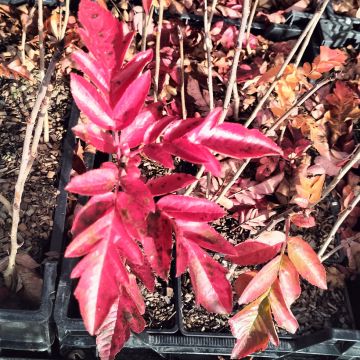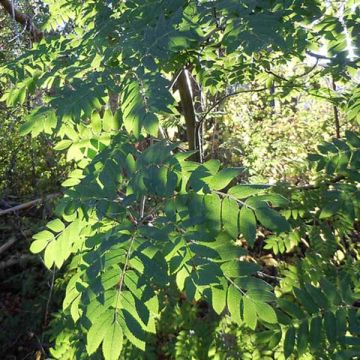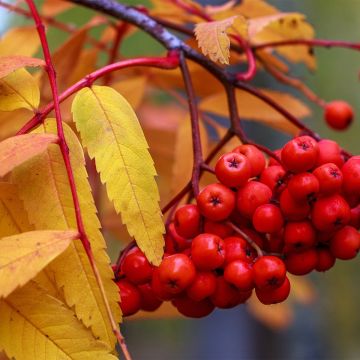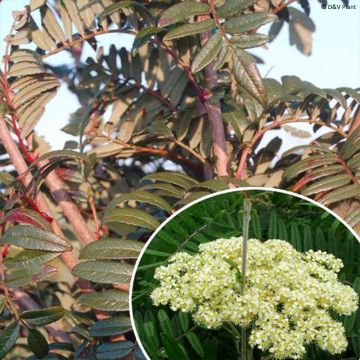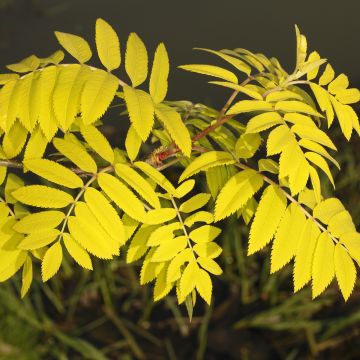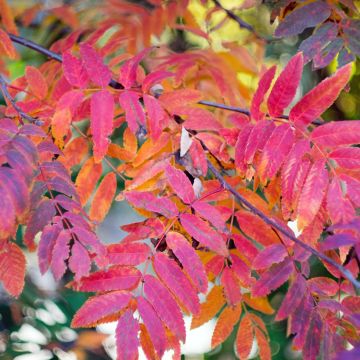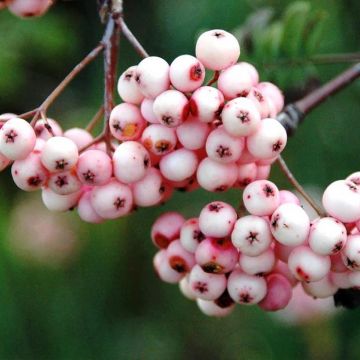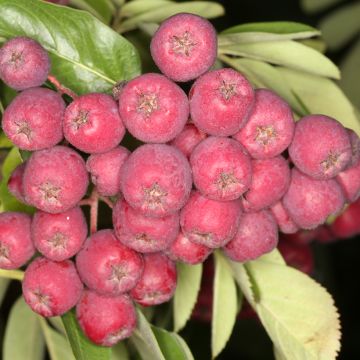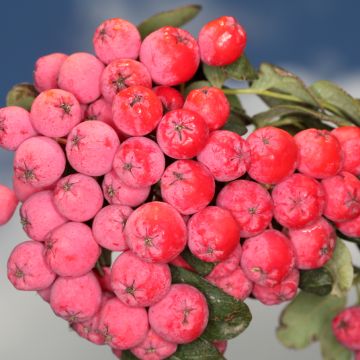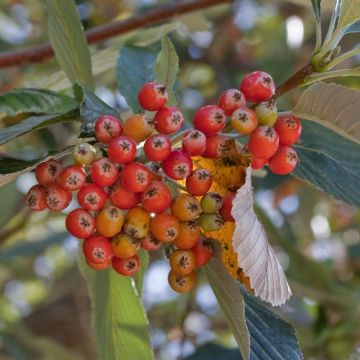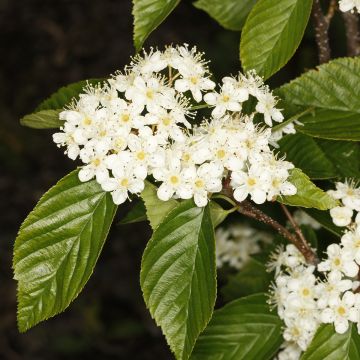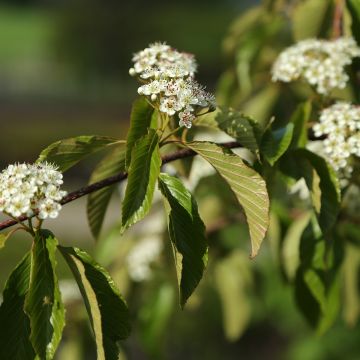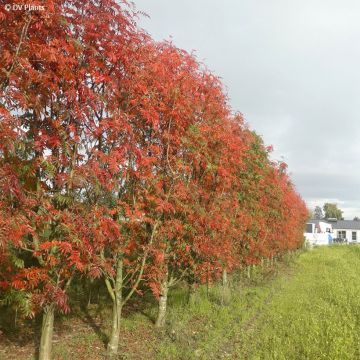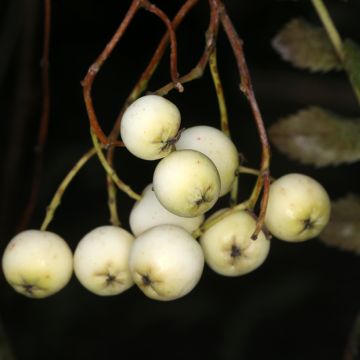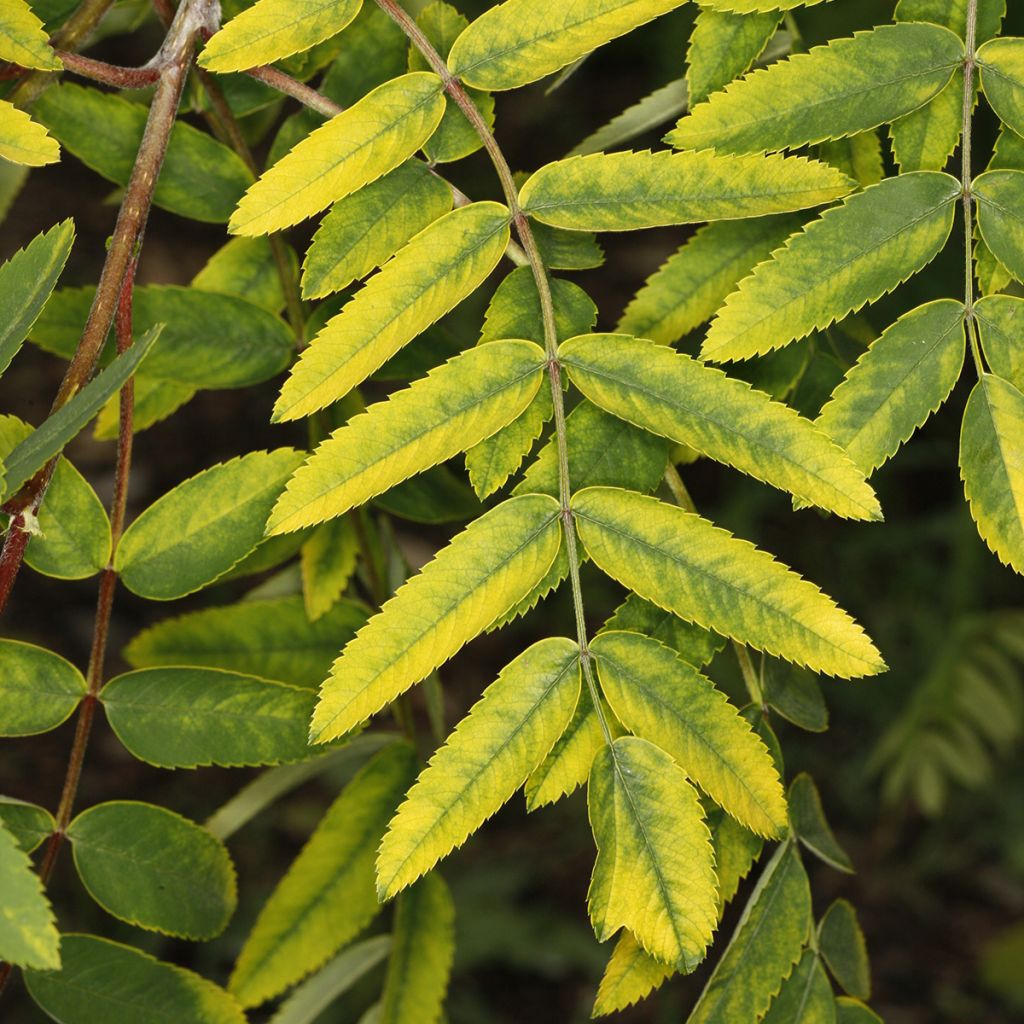

Sorbus aucuparia Pendula Variegata
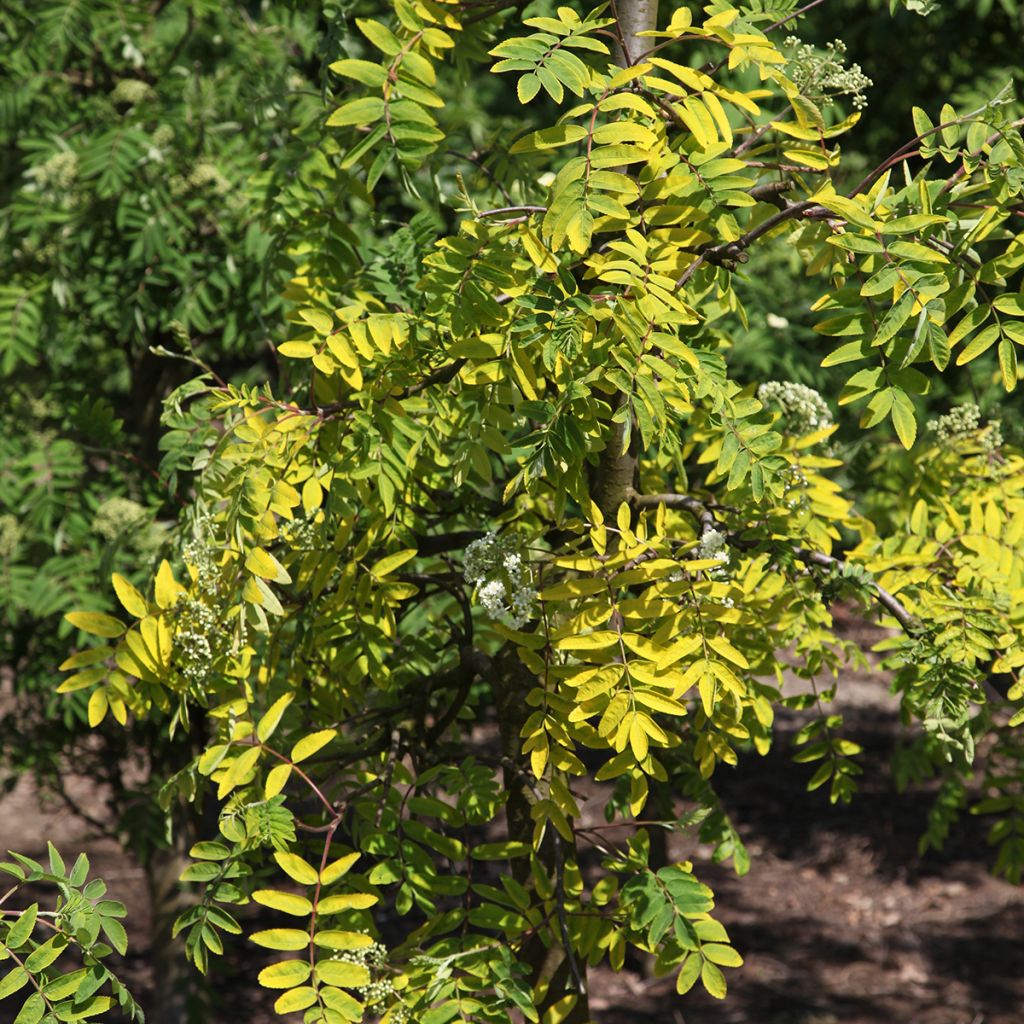

Sorbus aucuparia Pendula Variegata
Sorbus aucuparia Pendula Variegata
Sorbus aucuparia Pendula Variegata
Rowan, Mountain ash
Why not try an alternative variety in stock?
View all →This plant carries a 24 months recovery warranty
More information
We guarantee the quality of our plants for a full growing cycle, and will replace at our expense any plant that fails to recover under normal climatic and planting conditions.
Oversize package: home delivery by special carrier from €6.90 per order..
Express home delivery from €8.90.
Does this plant fit my garden?
Set up your Plantfit profile →
Description
Sorbus aucuparia Pendula Variegata is a variety of rowan tree with slow growth and weeping habit. It is a small tree that over time forms a wide crown, wider than its height. Its compound foliage is characteristic of the botanical species in terms of its very delicate design, however, it displays a unique yellow variegation that enhances its ornamental interest. It is very hardy and adapts to most soils, except those that are too chalky or dry, and prefers to grow in the sun while tolerating partial shade. A very rare plant although easy to cultivate.
The rowan tree, in Latin Sorbus aucuparia, is a tree that reaches about fifteen metres in height and in the countryside grows in hedges, along paths or at the edge of woods. Its natural distribution range is immense, covering a large part of Europe, Russia and temperate Asia up to Japan. Its great hardiness and tolerance to various natural conditions, whether in terms of soil or climate, explain the species' ability to spread. Its berries serve as a pantry for wild birds. A member of the large Rosaceae family, there are dozens of species.
'Pendula Variegata' is an extremely rare variety in cultivation, mostly known to collectors. It grows much slower than the species, eventually forming a compact tree about 3 or 4 metres tall and 1 metre wider. Its growth is so slow that the crown generally only progresses about fifty centimetres in 10 years. Considering that its average lifespan is approximately fifty years, it is therefore a variety intended for enthusiasts.
Although patience is required to admire it in its full development, with its crown billowing under the effect of irregularly arched branches, young specimens already present an ornamental interest. Its odd-pinnate foliage is composed of quite numerous leaflets (9 to 17, on average 13), thin and elongated, with a toothed margin. The very delicate, green leaves are strongly margined with yellow. This variegation is uneven, some leaves are just speckled with yellow, while others are mostly yellow, with the green colour sometimes only persisting in the veins. This is also why its growth is so slow, as the green chlorophyll surface is considerably reduced compared to the original species... The flowering in white corymbs of about 12 cm in diameter appears in May and attracts bees. The flowers are followed by numerous clusters of red to orangish fruits, approximately 1 cm in diameter and very decorative, which delight the birds that feed on them until the end of the year. Flowering and fruiting are comparable to the botanical species, although less abundant.
This rowan tree is best planted in the sun, but it tolerates partial shade for part of the day. It is not demanding in terms of soil, even accepting very acidic, neutral, or moderately chalky soils. It prefers a certain moisture, it can tolerate drier soils but long periods of drought can cause the tips of the leaves to turn brown. Very hardy (down to -29°C), it can be planted anywhere except in coastal areas, as it has no tolerance to salt. Windy locations that could damage its crown should also be avoided.
Sorbus aucuparia Pendula Variegata combines decorative foliage, flowering, and fruiting, as well as a very architectural habit. Its small size allows it to fit in any garden, preferably as a standalone specimen to highlight its assets, or within a small mixed bed. Low-growing plants should be chosen to match its reduced dimensions and slow growth rate. Physocarpus opulifolius Black Light, a shrub with almost black dark purple foliage, will be a perfect companion. With its slow growth, this shrub, about 1.50 m in all directions, produces a contrasting white flowering on the dark foliage in June-July, taking over from the Rowan's flowering. Viburnum tinus Gwenllian is a variety of Laurustinus with comparable dimensions, whose glossy dark green evergreen foliage is ornamental all year round, and whose late winter flowering is particularly decorative, when the red buds formed in winter open into a myriad of small white flowers. In addition to leaves, flowers, and fruits, decorative barks should not be forgotten, such as that of Cornus sanguinea Magic Flame, a Dogwood with yellow, red, and orange wood, particularly attractive in winter. Its green-yellow foliage in summer turns bright orange in autumn.
Report an error about the product description
Plant habit
Flowering
Foliage
Botanical data
Sorbus
aucuparia
Pendula Variegata
Rosaceae
Rowan, Mountain ash
Cultivar or hybrid
Other Sorbus - Mountain Ash
Planting and care
Sorbus aucuparia 'Pendula Variegata' is best planted in autumn in most soils, preferably moist (but tolerates dry), acidic, neutral or slightly chalky. Not demanding, it adapts to loamy, clayey or sandy soils, while having a preference for deep soil. Choose a sunny location, or possibly slightly shaded, and sheltered from the wind, as its wide crown is sensitive to it. It is also not suitable for the coast, not tolerating either sea spray or the presence of salt in the soil. Dig a planting hole 60 cm on each side and at the bottom and add some compost to the bottom if the soil is poor. Soak the container in a bucket for fifteen minutes to thoroughly saturate the root ball before placing it in the planting hole. Fill in and water abundantly; monitor watering for the first two years to allow the tree to establish well.
Planting period
Intended location
Care
This item has not been reviewed yet - be the first to leave a review about it.
Haven't found what you were looking for?
Hardiness is the lowest winter temperature a plant can endure without suffering serious damage or even dying. However, hardiness is affected by location (a sheltered area, such as a patio), protection (winter cover) and soil type (hardiness is improved by well-drained soil).

Photo Sharing Terms & Conditions
In order to encourage gardeners to interact and share their experiences, Promesse de fleurs offers various media enabling content to be uploaded onto its Site - in particular via the ‘Photo sharing’ module.
The User agrees to refrain from:
- Posting any content that is illegal, prejudicial, insulting, racist, inciteful to hatred, revisionist, contrary to public decency, that infringes on privacy or on the privacy rights of third parties, in particular the publicity rights of persons and goods, intellectual property rights, or the right to privacy.
- Submitting content on behalf of a third party;
- Impersonate the identity of a third party and/or publish any personal information about a third party;
In general, the User undertakes to refrain from any unethical behaviour.
All Content (in particular text, comments, files, images, photos, videos, creative works, etc.), which may be subject to property or intellectual property rights, image or other private rights, shall remain the property of the User, subject to the limited rights granted by the terms of the licence granted by Promesse de fleurs as stated below. Users are at liberty to publish or not to publish such Content on the Site, notably via the ‘Photo Sharing’ facility, and accept that this Content shall be made public and freely accessible, notably on the Internet.
Users further acknowledge, undertake to have ,and guarantee that they hold all necessary rights and permissions to publish such material on the Site, in particular with regard to the legislation in force pertaining to any privacy, property, intellectual property, image, or contractual rights, or rights of any other nature. By publishing such Content on the Site, Users acknowledge accepting full liability as publishers of the Content within the meaning of the law, and grant Promesse de fleurs, free of charge, an inclusive, worldwide licence for the said Content for the entire duration of its publication, including all reproduction, representation, up/downloading, displaying, performing, transmission, and storage rights.
Users also grant permission for their name to be linked to the Content and accept that this link may not always be made available.
By engaging in posting material, Users consent to their Content becoming automatically accessible on the Internet, in particular on other sites and/or blogs and/or web pages of the Promesse de fleurs site, including in particular social pages and the Promesse de fleurs catalogue.
Users may secure the removal of entrusted content free of charge by issuing a simple request via our contact form.
The flowering period indicated on our website applies to countries and regions located in USDA zone 8 (France, the United Kingdom, Ireland, the Netherlands, etc.)
It will vary according to where you live:
- In zones 9 to 10 (Italy, Spain, Greece, etc.), flowering will occur about 2 to 4 weeks earlier.
- In zones 6 to 7 (Germany, Poland, Slovenia, and lower mountainous regions), flowering will be delayed by 2 to 3 weeks.
- In zone 5 (Central Europe, Scandinavia), blooming will be delayed by 3 to 5 weeks.
In temperate climates, pruning of spring-flowering shrubs (forsythia, spireas, etc.) should be done just after flowering.
Pruning of summer-flowering shrubs (Indian Lilac, Perovskia, etc.) can be done in winter or spring.
In cold regions as well as with frost-sensitive plants, avoid pruning too early when severe frosts may still occur.
The planting period indicated on our website applies to countries and regions located in USDA zone 8 (France, United Kingdom, Ireland, Netherlands).
It will vary according to where you live:
- In Mediterranean zones (Marseille, Madrid, Milan, etc.), autumn and winter are the best planting periods.
- In continental zones (Strasbourg, Munich, Vienna, etc.), delay planting by 2 to 3 weeks in spring and bring it forward by 2 to 4 weeks in autumn.
- In mountainous regions (the Alps, Pyrenees, Carpathians, etc.), it is best to plant in late spring (May-June) or late summer (August-September).
The harvesting period indicated on our website applies to countries and regions in USDA zone 8 (France, England, Ireland, the Netherlands).
In colder areas (Scandinavia, Poland, Austria...) fruit and vegetable harvests are likely to be delayed by 3-4 weeks.
In warmer areas (Italy, Spain, Greece, etc.), harvesting will probably take place earlier, depending on weather conditions.
The sowing periods indicated on our website apply to countries and regions within USDA Zone 8 (France, UK, Ireland, Netherlands).
In colder areas (Scandinavia, Poland, Austria...), delay any outdoor sowing by 3-4 weeks, or sow under glass.
In warmer climes (Italy, Spain, Greece, etc.), bring outdoor sowing forward by a few weeks.

































